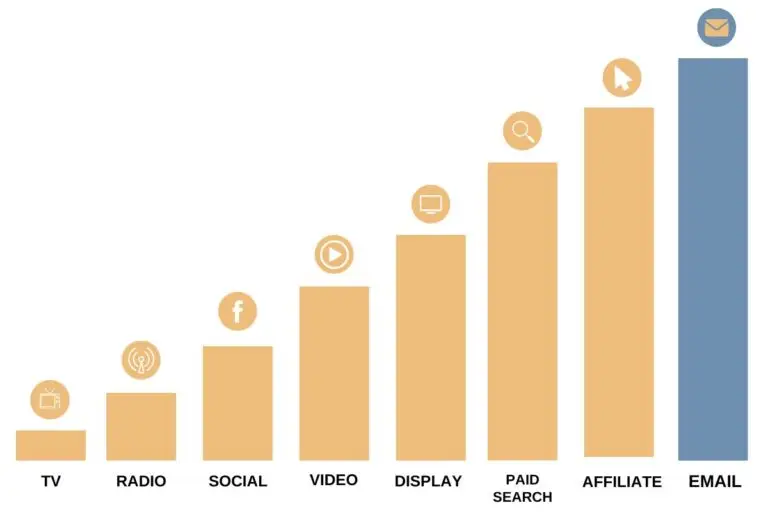
Daily, over 360 billion emails are sent.
By 2025, we’re looking at a surge to 376 billion emails each day.
However, the approach to email marketing is constantly evolving.
Strategies effective five years back may not hold up today.
Yet, it remains an essential component of any marketing plan.
In fact 87% of brands said that email marketing contributes to their business’ success and for 4 out of 5 marketers say that they would rather give up social media marketing than email marketing.
The reason?
It consistently achieves impressive outcomes and offers the highest ROI.

For a full decade, email marketing has been the top dog, fetching on average $42 for every $1 spent.
Custom-crafted subject lines can lead to a 26% jump in open rates, while segmented campaigns have unlocked a 760% surge in revenue.
With 80% of consumers favouring businesses that tailor their approach, the impact of personalisation is more than just fetching—it’s a proven strategy that’s been leading the pack for ten years running.
Now, let’s dig up some top-notch email marketing strategies that promise not just to multiply your returns but to help your pet business paw-sitively stand out from the pack!
The first step to creating your email marketing plan is to set goals for what you want to accomplish with your email marketing efforts tailored to your pet brand.
Are you looking to increase clicks through to your website for your new line of organic pet treats? Or perhaps boost sales of your eco-friendly pet accessories?
A specific and measurable goal makes it easier to determine whether you’ve achieved it. In this case, if your sales for the premium dog food line are 7% higher by the end of the quarter, you’ve met your goal.
Identify the key performance indicators (KPIs) that will measure your success. In this scenario, the KPI would be the percentage increase in sales for the premium dog food line. This clear linkage between goals and KPIs ensures your efforts are focused and effective.
By focusing on clear, relevant goals and metrics, you can align your email marketing efforts with your business objectives and contribute to the growth and engagement of your pet brand.
The second step to developing your email marketing strategy is to research your target audience. You want to know your audience as much as you can—beyond basic demographic information like their age and gender.
Creating a customer avatar can be a significant first step in getting to know your audience. This in-depth exploration of your target audience delves into details like their pets, hobbies, passions, and values. This matters since 71% of customers prefer buying from brands that align with their personal values.
Once you know your target audience, you can begin researching the type of content they might find most appealing.
Target audience research might include:
For example, if you run a company that sells organic pet food and your research indicates that pet owners are highly concerned about the ingredients and sourcing of their pets’ food, you might note that it would be a good idea to highlight your product’s organic certification and ethical sourcing practices.
These notes can kickstart your brainstorming and help you develop solid themes and topics for your upcoming email campaigns, ensuring they resonate with pet owners and address their specific concerns and interests.
Segmenting your email lists is a vital part of a winning email marketing strategy for pet brands. This is because not all of your customers have the same needs and interests when it comes to their pets.
For example, consider a company that offers a variety of pet services and products, including grooming, pet boarding, and specialty pet diets. The customers benefiting directly from these services have different priorities based on their pets’ specific needs.
Pet owners who use your grooming services will be interested in content that provides grooming tips, seasonal grooming needs, and exclusive grooming product offers.
In contrast, customers who rely on your pet boarding services will want information on the safety and comfort of your facilities, tips on preparing pets for boarding, and special promotions for long-term stays.
These two groups of customers require different messaging. Grooming service users will benefit from content that showcases grooming before-and-after photos, DIY grooming tips, and recommendations for maintaining their pet’s coat between visits. Pet boarding customers, on the other hand, will appreciate articles on reducing separation anxiety, behind-the-scenes looks at your boarding facilities, and customer testimonials about their pets’ stays.
Segmenting groups with different needs into their own email lists allows you to send targeted emails that matter to your recipients. This approach can increase your email open rate, position your brand as an authority on the subject, and improve customer engagement and loyalty.
According to Campaign Monitor, 74% of online consumers get frustrated when content like offers, ads, and promotions are not aligned with their interests.
Identify key dates and holidays relevant to your pet business. These could include National Pet Day, Adopt a Shelter Pet Month, or your business’s anniversary. Planning special promotions or themed content around these dates is crucial because it helps engage your audience, making your emails timely and relevant. Highlighting seasonal products and creating timely campaigns can boost engagement, drive sales, and strengthen your connection with your customers.
By aligning your email content with these important dates, you capitalize on moments when pet owners are already thinking about celebrating their pets, increasing the likelihood of interaction and conversion.
Create an email marketing calendar to schedule your campaigns. This helps ensure consistent communication and allows you to plan ahead for important dates and promotions. Include details like the type of content, target audience segment, and specific goals for each campaign. Regularly review and adjust your calendar based on performance metrics.
By aligning your email content with these important dates, you capitalize on moments when pet owners are already thinking about celebrating their pets, increasing the likelihood of interaction and conversion.
Automated flows help you create efficient, personalized customer journeys by sending timely messages triggered by real-time behavior. Flows are powerful, and they can require time to set up. But once they’re live, you can sit back and watch the revenue flow in.
For instance, sending a welcome email when a new subscriber joins your list or an abandoned cart reminder when a customer leaves items in their cart can significantly enhance engagement and conversion rates. By triggering emails at the right time, you can effectively nurture leads, recover lost sales, and build stronger customer relationships.
Regularly analyze the performance of your email campaigns using metrics like open rates, click-through rates, and conversion rates. Use this data to identify what’s working and what needs improvement. Continuously adjust your strategy based on these insights to optimize future campaigns.
Even with a top-notch email marketing strategy, success depends on the quality of your email content. Knowing how to grow your email list, create engaging and professional email content, and provide genuine value to your pet-loving customers will help your emails stand out. If pet owners consistently have positive experiences with your emails, they are less likely to ignore them and more likely to read and engage with your content.
Here are some essential tips for an effective email marketing strategy tailored to pet brands:
Focus on continuously growing your email list by providing value. Use pop-ups, sign-up forms, and social media promotions to attract new subscribers. Offer valuable incentives such as discounts, exclusive content, or a free pet care guide to encourage sign-ups.
It’s estimated that 50-60% of email opens come from mobile devices in 2024. Ensure your emails are mobile-friendly with responsive design, concise content, and easily clickable links. Test your emails on different devices to ensure a seamless experience for all subscribers.
Your subject line is the first thing your subscribers see, so make it count. Use catchy and engaging subject lines that encourage opens. For example, “10 Tips to Keep Your Pet Healthy and Happy” or “Exclusive Discount on Organic Pet Treats!” Personalization and urgency can also increase open rates.
Include clear and compelling calls to action (CTAs) in your emails. Whether it’s to shop a sale, read a blog post, or follow on social media, make sure it’s easy for the reader to take the next step. Use buttons and clear, concise language to direct your subscribers.
Ensure that every email provides value to your customers. Whether it’s educational content, exclusive discounts, or helpful tips, your emails should enhance the customer experience and build trust. For pet brands, this could include pet care advice, product recommendations, and stories from other pet owners.

Certified Klaviyo Email Marketing Expert | Pet Niche Specialist
